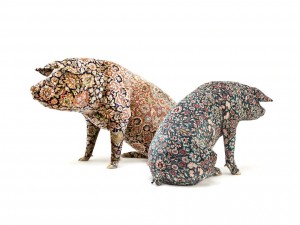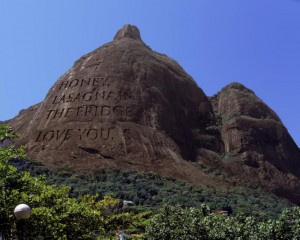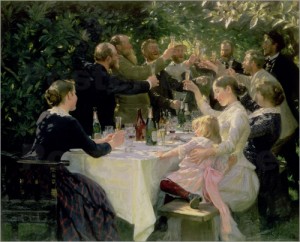 One of my favourite British TV shows is ‘Lost in Austen,’ a miniseries based on the premise that a 21st century anti-heroine suddenly finds herself in the middle of the plot of ‘Pride & Prejudice,’ filling in for a missing Elizabeth Bennett. And one of my favourite lines is when Mr. Wickham describes Lady Catherine de Bourgh as ‘the cloaca through which all society passes.’ I admit I had to go to the dictionary to find out what it meant, so in case you are equally at sea, a cloaca is ‘the common chamber into which the intestinal and urogenital tracts discharge especially in monotreme mammals, birds, reptiles, amphibians, and elasmobranch fishes’ or simply, the anus or ‘posterior hole through which waste passes from the body.’
One of my favourite British TV shows is ‘Lost in Austen,’ a miniseries based on the premise that a 21st century anti-heroine suddenly finds herself in the middle of the plot of ‘Pride & Prejudice,’ filling in for a missing Elizabeth Bennett. And one of my favourite lines is when Mr. Wickham describes Lady Catherine de Bourgh as ‘the cloaca through which all society passes.’ I admit I had to go to the dictionary to find out what it meant, so in case you are equally at sea, a cloaca is ‘the common chamber into which the intestinal and urogenital tracts discharge especially in monotreme mammals, birds, reptiles, amphibians, and elasmobranch fishes’ or simply, the anus or ‘posterior hole through which waste passes from the body.’
OK, before I lose you, there is a reason I am drawing your attention to such base matter. As a food writer, I have studied the correct table settings for an 18th century banquet, the contents of a mediaeval kitchen garden, the recipe books of the early twentieth century. And I continuously indulge in many poetic and philosophical tales of dining, both past and present. But let’s face it, the inevitable result of a meal, however spectacular, delicious and Michelin starred is a trip to the comfort room, lavatory, loo or toilet. Yet it is an outcome to eating we generally prefer to ignore.
Not so Wim Delvoye, a Belgian artist based in Britain, who is renowned for his love of challenging our perspective on ‘life, the universe and everything.’ Or as Robert Enright wrote, “Delvoye is involved in a way of making art that reorients our understanding of how beauty can be created”.
Last month I got a good look at his offbeat interpretation of the world when I visited the Musée d’Art Moderne Grand-Duc Jean (Mudam) Luxembourg, which is celebrating its tenth anniversary with a retrospective on Wim Delvoye,  the artist who contributed to its opening in 2006. The Mudam Gallery perches on the edge of Kirchenberg, the business park on the plateau above the mediaeval town of Luxembourg. Surrounded on three sides by woodland, and built on the remains of Fort Thüngen, it is described as ‘a marvellous dialogue between the natural and historical environment.’ And it is light and bright and spacious, made with a honey coloured limestone called Magny Doré, and plenty of glass. It is a great setting for Delvoye’s strange creations.
the artist who contributed to its opening in 2006. The Mudam Gallery perches on the edge of Kirchenberg, the business park on the plateau above the mediaeval town of Luxembourg. Surrounded on three sides by woodland, and built on the remains of Fort Thüngen, it is described as ‘a marvellous dialogue between the natural and historical environment.’ And it is light and bright and spacious, made with a honey coloured limestone called Magny Doré, and plenty of glass. It is a great setting for Delvoye’s strange creations.
‘Basically, Wim Delvoye makes oxymorons’ says Michel Onfray in the gallery’s official gallery guide, his artwork
defined thus as contradictory, or incongruous. I disagree about contradictory, but incongruous I will allow. And Mr. Delvoye’s art is, without question, provocative.
Delvoye likes to make art out of the starkly industrial: carving floral motifs into huge, rubber tractor tyres that remind me of Indian soapstone carvings; a cement mixer carved from highly polished teak; another made of filigreed  steelwork that resembles a Gothic cathedral; sawblades enameled in blue and white images like Dutch tiles and displayed in glass cabinets. Then there are others that mock the modern notion that bigger is better: the vast photographs of cliff faces inscribed with the mundane words of a Post-it note or toilet door. ‘SWEETHEART, OUT FOR PIZZA, BACK IN 10 MINS. GIANNI,’ or ‘RUDE BUT CUTE 18 YEAR OLD BABE 018 83 87 480.’ And then there are his live pigs tattooed in skulls and flowers and religious images.
steelwork that resembles a Gothic cathedral; sawblades enameled in blue and white images like Dutch tiles and displayed in glass cabinets. Then there are others that mock the modern notion that bigger is better: the vast photographs of cliff faces inscribed with the mundane words of a Post-it note or toilet door. ‘SWEETHEART, OUT FOR PIZZA, BACK IN 10 MINS. GIANNI,’ or ‘RUDE BUT CUTE 18 YEAR OLD BABE 018 83 87 480.’ And then there are his live pigs tattooed in skulls and flowers and religious images.
‘I want to make fearless art’ he is reported as saying last year in the magazine Robb Report.
Perhaps his most fearless – certainly his most abrasive and bothersome pieces – are the many versions of his cloaca construction. Fusing art and science, Delvoye recreated the human digestive system, after eight years of consultation with experts in plumbing and gastroenterology. He even installed a permanent, custom-built cloaca for MONA, the Museum of Old and New Art in Hobart, Tasmania. The first one we came across in the Mudam looked a bit like a stationary steam engine. Using tanks and tubes, which he feeds with sugars and acids, gastric juices and real food, he examines in intriguing detail the journey from mouth to lavatory bowl, a daily bodily function that we publicly prefer to ignore, and yet cannot disconnect from the equally mundane, but less disturbing need to eat. Each cloaca is a digestive machine that processes what goes in, and passes out the waste product from a sausage machine at the end, like a dollop of human poo. Apparently, you can even buy jars of this fecal by-product suspended in resin in his store. Useless art? Totally. I guess that’s his point. And yet as a representation of a necessary human function, why is it less attractive than all those paintings we love of family gatherings around the dining table or a still life of food and fruit bowls? Beautiful porcelain crockery? Waterford crystal glasses?
Poo may not be pretty, but Delvoye will not allow it to hide from public view. It is on display in the centre of the floor
like the metaphorical elephant in the room. Like the King’s commode. An obvious, unalterable, uncomfortable truth that we prefer to ignore.
I came away enlightened and impressed. But if I am honest, I would still prefer a reproduction of P.S. Krøyer’s oil painting of a 19th century luncheon party, Renoir’s ‘Luncheon of the Boating Party,’ or even Da Vinci’s ‘Last Supper’ in my living room to one of Delvoye’s jars of faeces in amber!
*With thanks to Google Images for providing the pics after a glitch in modern technology swallowed all our photos!
